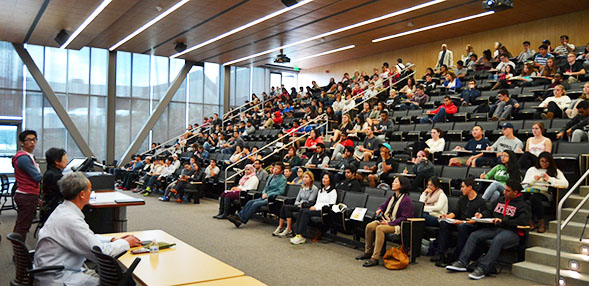Unlocking New Possibilities
A team of SDSU entrepreneurs has created a program that engages students by transforming the traditional learning experience through technology.

Course Key — a higher education software management platform —is being used to increase student-teacher interaction on college campuses.
Course Key equips students with tools like classmate chatrooms and a lecture note recording feature, all easily accessed on their smart phone, tablet or laptop.
The Course Key team consists of :
- Luke Sophinos: Communication, Marketing, and Entrepreneurship
- Ryan Vanshur: International Business
- Marc Barron: Finance
- Fadee Kannah: Computer Engineering, Computer Science
- Fadi George: Computer Engineering, Applied Mathematics, and Computer Science
- Michael Woo: Computer Science
- Chris Parsoneault: Programmer
- Alex Salerno: Programmer
Founder and CEO of Course Key, Luke Sophinos used his experience at SDSU to create a program that engages students in large lecture classes. Course Key offers unique features that keep students off social media and engaged with their professors.
Course Key helps faculty as well, giving them tools to send multiple choice quizzes and polls directly to their students' devices.
Students also benefit from high-tech capabilities such as syncing their syllabus to their device’s calendar and receiving notifications before assignments are due.
1. How did you get this idea? Where did the inspiration come from?
I came from a high school in Colorado, where class sizes were small. I basically got thrown off my feet when three out of the five classes I was in were taught in large lecture halls. I felt these large classes created a disconnect between my fellow students and the instructor.
2. What does your company do?
Course Key is a higher education software management platform that is used to enhance communications in large lecture settings between professors and students. Data analysis from a recently completed pilot-study confirmed the product’s ability to boost student success using features that increase classroom attendance, encourage student participation, and promote social learning. By leveraging mobile technology for academia, the interface eases the transition to collaborative, tech-based teaching methods for all stages of adopters. Built by students in collaboration with educators, Course Key is an interactive cross-platform application that looks to revolutionize the higher education classroom learning experience.
3. How has SDSU helped you be successful?
SDSU is an incredible campus for entrepreneurs and those that want to start their own business. With the on campus incubator, the Zahn Innovation Center and the Lavin Entrepreneurship Center, I was able to really connect with the staff and faculty of both. All these individuals are incredible and have taken our team and company to the next level. Whether it was introductions to successful San Diego Entrepreneurs or Software Scrum training, this campus has given us the resources to effectively scale our business.
4. What are the next steps and goals for the future?
We are currently raising our first round of funding. That has been a non-stop and complex process. Our goal is to close that deal by the end of August and have a successful fall launch.
5. Are you involved with anything else at SDSU?
I am a graduate of the Zahn Innovation Center, a member of SDSU’s Entrepreneur Society and a Lavin Fellow at the Lavin Entrepreneurship Center.
6. How has your involvement with the university’s entrepreneurship centers helped your business grow?
Course Key was built from the idea stage all the way to our beta test with 5,000 users with constant involvement from both the Zahn Innovation Center and the Lavin Entrepreneurship Center. The Zahn Center accepted our idea last May and has helped us evolve into what we are today. With Lavin, they recently sent us to Utah for the International Business Model Competition where we received an honorable mention and finished top 11 out of more than 3,800 student-run companies from across the globe. Without their guidance and preparation we would not have experienced that incredible opportunity.



